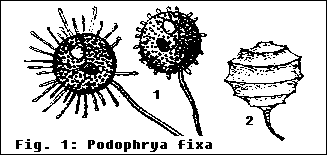 Podophrya fixa approx. 220x
Active Individuals -{1}, Cyst -{2}.
Podophrya fixa approx. 220x
Active Individuals -{1}, Cyst -{2}. I have recently come across a very interesting cilate, Podophyra. I have been watching this for the past few days, and it is always good to spend a bit of time on one organism, reading about it and its like in various books and generally immersing yourself in it.
Podophyra is a ciliate protozoan, which means it is in the same phylum as good old Paramecium. I say phylum and I must qualify this statement. Ciliates are single-celled organisms that until recently were classified as a subphylum within the phylum Protozoa. Since the protozoa are now part of the Protoctista Kingdom, protozoa as a taxanomic group does not exist and the previous subphyla such as the Ciliates have now become full-blown Phyla. The phylum is divided into three classes of which Podophyra belongs to the Kinetofragminophora. Within this class there is the subclass Suctoria, and Podophyra is a suctorian.
At first sight the suctorians would appear to have little in common with the rest of the Ciliates since the adult cells are without cilia! However closer inspection reveals that they do retain the kinetosomes (basal body of the cilia) which are scattered throughout the cytoplasm and then passed on to the larval form during budding. These kinetosomes give rise to cilia in the normal way in these larvae.
 Podophrya fixa approx. 220x
Active Individuals -{1}, Cyst -{2}.
Podophrya fixa approx. 220x
Active Individuals -{1}, Cyst -{2}.
The most obvious suctorian feature are the hollow suctorial tentacles. These often have knobs on the end like a pin-head. These tentacles are concerned with food capture and ingestion, particularly of other protozoa and often other ciliates. The majority of the group are sessile, and attach themselves to a variety of submerged objects, including other organisms, often by means of a stalk.
Podophyra has a spherical to ovoid body on a hollow rigid stalk. The tentacles are capitate (like pin-heads) and there are between 30-60 distributed over the whole body surface. There is no lorica and it readily encysts. Reproduction is by exogenous budding, that is the ciliated larva develops outside of, and therefore separates from the adult cell. This seems to occur soon after feeding.
The mode of feeding involves gaining a firm grip on the prey eg. the ciliate Colpidium with a tentacle. The knob at the end contains extrusomes which are oragnelles used to hold the ciliate by narcotisising it. Once the food is captured, the cytoplasm is sucked down the arms into the body. The ciliate remains alive as cytoplasm is sucked along the arm! After feeding the cytoplasm of Podophyra takes on a rather granular appearance. The prey may be released alive after feeding is complete, a most polite gesture!
Mike Samworth
Illustration from "Fresh-Water Biology by Ward &
Whipple (c) 1918
London: Chapman & Hall Ltd.
Note: Every Pond-life microscopist's bible!
Please report any Web problems
or offer general comments to the Micscape Editor,
via the contact on current Micscape Index.
Micscape is the on-line monthly
magazine of the Microscopy UK web
site at Microscopy-UK